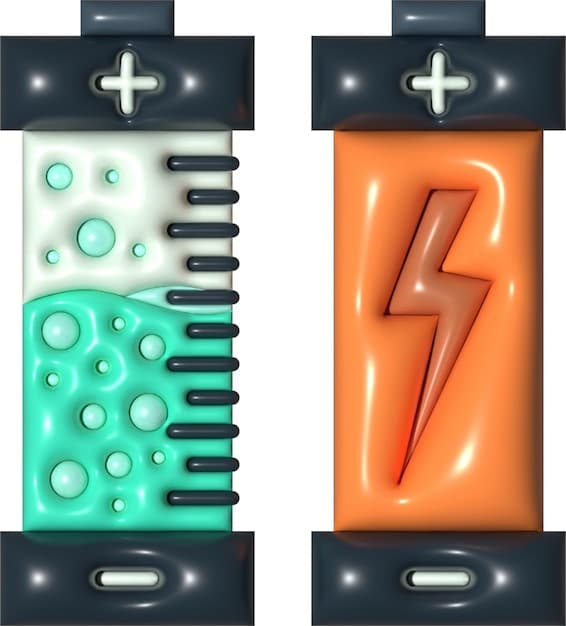Emerging Energy Storage Technologies: Dominating the US Market by 2030

By 2030, the US energy storage market will likely be dominated by advancements in lithium-ion batteries, flow batteries, solid-state batteries, and hydrogen storage, driven by increasing demand for grid-scale storage, electric vehicles, and renewable energy integration.
The energy landscape is rapidly evolving, and the demand for efficient and reliable energy storage solutions is growing exponentially. So, what emerging energy storage technologies will dominate the US market by 2030?
Forecasting the Energy Storage Revolution in the US
The US energy storage market is on the cusp of a revolution, driven by the increasing adoption of renewable energy sources, the rise of electric vehicles, and the need for grid stabilization. Several emerging technologies are poised to play a significant role in shaping this landscape. Understanding these technologies is crucial for investors, policymakers, and anyone interested in the future of energy.
The United States is committed to transition to a clean energy economy. Innovation in the energy sector is crucial to provide clean, reliable secure and affordable electricity to all Americans. As a result, the United States is expected to increase its storage capacity to 85 GW by 2030.

The Rise of Advanced Lithium-Ion Batteries
Lithium-ion batteries have already established themselves as a dominant force in the energy storage market. Ongoing research and development are producing advanced lithium-ion batteries with greater energy density, longer lifespans, and improved safety features. These advancements will solidify their position for years to come. This includes adoption in electric vehicles and grid-scale storage.
Lithium-ion batteries have proven to be scalable and a cost-effective solution for multiple use cases. These advancements will translate to enhance energy efficiency and environmental sustainability.
- Increased Energy Density: New materials and cell designs are enabling lithium-ion batteries to store more energy in a smaller volume.
- Extended Lifespan: Improvements in battery chemistry and management systems are significantly prolonging the cycle life of lithium-ion batteries.
- Enhanced Safety: Innovations in thermal management and electrolyte materials are reducing the risk of thermal runaway and fires.
- Lower Costs: Economies of scale and advancements in manufacturing processes are driving down the cost of lithium-ion batteries.
Advanced lithium-ion batteries will continue to evolve, maintaining their relevance in the energy storage market through continuous innovation and cost optimization.
Flow Batteries: Scalable and Sustainable
Flow batteries are emerging as a strong contender for grid-scale energy storage applications. These batteries use liquid electrolytes stored in external tanks, allowing for independent scaling of energy capacity and power output. This modular design makes flow batteries particularly well-suited for large-scale energy storage projects.
The nature of flow batteries, including their environmentally sustainable materials and long lifespans, positions them as long-term strategic solution for energy storage.
Key Advantages of Flow Batteries
Flow batteries have a number of advantages that make them a compelling alternative to lithium-ion batteries for certain applications. For example, they offer unparalleled scalability to meet the demands of power grids.
- Independent Scaling: Flow batteries allow for independent scaling of energy capacity and power output.
- Long Lifespan: Liquid electrolytes ensure minimal degradation over time which extends the operational life of flow batteries
- High Safety: The non-flammable nature of liquid electrolytes reduces the risk of thermal management concerns.
- Environmental Friendliness: The use of common, non-rare earth materials can provide sustainability benefits to flow batteries
Flow batteries are poised to become a mainstream solution for grid-scale energy storage, offering a compelling combination of scalability, longevity, and safety.
Solid-State Batteries: The Next Generation of Energy Storage?
Solid-state batteries are widely regarded as the next generation of energy storage technology. Replacing the liquid electrolyte with a solid material, these batteries offer the potential for higher energy density, improved safety, and longer lifespan. While still in the early stages of commercialization, solid-state batteries are attracting significant investment and research efforts.
Solid-state batteries will play an increasingly important role in the future US energy storage market. The adoption of solid-state batteries is not just a technological upgrade, but a fundamental improvement in battery technology including efficiency, safety and overall performance.

Benefits and Challenges of Solid-State Batteries
Solid-state batteries can transform the landscape because they offer higher energy density with less degradation over time, leading to longer lifespans. However, the technology also faces several challenges before it is ready for widespread deployment.
The deployment of solid-state batteries include their application in electric vehicles and potentially even large grid-scale storage applications.
- Higher Energy Density: Solid electrolytes enable the use of high-voltage and high-capacity electrode materials.
- Enhanced Safety: Solid electrolytes are non-flammable and eliminate the risk of electrolyte leakage.
- Longer Lifespan: Solid-state batteries will have higher cycle lives due to the solid-electrolyte interface.
- Manufacturing Challenges: Manufacturing solid-state batteries at scale is complex and requires new production techniques.
Solid-state batteries hold immense promise for the future of energy storage, offering a compelling combination of performance and safety. Addressing the manufacturing challenges will be key to unlocking their full potential.
Hydrogen Storage: A Long-Term Solution
Hydrogen storage is emerging as a long-term solution for large-scale energy storage. By using hydrogen as an energy carrier, excess renewable energy can be stored and then converted back into electricity when needed. Hydrogen storage technologies can provide seasonal energy storage, contributing to overall grid stability.
Hydrogen storage is scalable and sustainable which makes it a viable option for reducing reliance on fossil fuels. It is a strategic investment that could reshape the future of energy.
Methods of Hydrogen Storage
There are several methods for storing hydrogen, each with its own advantages and disadvantages. However, technological advances has been made over the years to improve the feasibility of storing hydrogen for energy.
- Compressed Hydrogen: Storing hydrogen as a compressed gas requires high-pressure tanks and significant energy input.
- Liquid Hydrogen: Liquefying hydrogen requires cryogenic temperatures.
- Material-Based Storage: Storing hydrogen in solid materials such as metal hydrides or chemical hydrides may require further enhancements.
- Underground Storage: Underground caverns or geological formations will make it possible to store hydrogen at scale.
Hydrogen storage is a promising long-term solution for large-scale energy storage, offering the potential for seasonal storage and grid stabilization. Addressing the technology and infrastructure challenges will be key to unlocking its full potential.
The Role of Grid-Scale Energy Storage
Grid-scale energy storage is crucial for integrating intermittent renewable energy sources such as solar and wind power into the electricity grid. By storing excess renewable energy and releasing it when demand is high, grid-scale storage can enhance grid reliability and reduce reliance on fossil fuels. Emerging energy storage technologies, such as flow batteries and hydrogen storage, are well-suited for these applications given their scalability and long lifespans. The integration of emerging technologies will prove to be beneficial to the United States.
Grid-scale energy storage will require a combination of batteries and technology to fully provide power to the US grid. While costs have previously been a concern, costs are expected to significantly decrease by 2030, especially with the use of emerging technologies.
Benefits of Grid-Scale Energy Storage
Grid-scale energy storage offers a wide range of benefits, from enhanced grid reliability to reduced carbon emissions. These systems ensure stable and continuous power delivery which helps to accommodate for grid imbalances.
- Enhanced Grid Reliability: Grid-scale storage improves grid stability and reduces the risk of blackouts.
- Renewable Energy Integration: Storage enables integration of renewable energy sources by storing them for later use.
- Peak Shaving: Energy storage can reduce demand during peak hours, lowering energy costs.
- Ancillary Services: Storage can provide ancillary services such as frequency regulation and voltage support.
Grid-scale energy storage is an essential component of a modern, reliable, and sustainable electricity grid. Emerging technologies will play a key role in enabling the widespread deployment of grid-scale storage solutions.
Policy and Investment Trends
Government policies and private investments are playing a significant role in accelerating the development and deployment of emerging energy storage technologies. Government incentives, tax credits, and mandates are incentivizing the adoption of energy storage systems. Venture capital investments, corporate funding, and public-private partnerships are driving innovation in the energy storage sector. This increase in attention will translate to lower costs.
The United States government recently enacted the Inflation Reduction Act. This provides incentives for the development and implementation of energy storage systems. It also provides tax credits for electricity that have low gas emissions.
The Impact of Government Policies
Government policies will play a central role in pushing forward the development and growth of energy storage technologies. Government incentives are designed to lower the barrier of entry and accelerate the adoption of sustainable practices. These can help reduce the cost and increase the efficiency of renewable energy storage.
- Tax Credits: Investment tax credits and production tax credits reduce the cost of energy storage projects.
- Mandates: Energy storage mandates require utilities to deploy a certain amount of energy storage capacity.
- Research and Development Funding: Government funding supports research and development efforts.
- Streamlined Permitting: Streamlined permitting processes can reduce the time and cost of deploying energy storage systems.
Government policies are essential for fostering innovation and accelerating the deployment of emerging energy storage technologies. Continued policy support will be crucial for achieving a sustainable energy future.
| Key Element | Brief Description |
|---|---|
| ⚡ Advanced Lithium-Ion | Higher energy density, longer lifespan, and enhanced safety. |
| 💧 Flow Batteries | Scalable, long-lasting, and ideal for grid-scale storage. |
| 🔋 Solid-State Batteries | Next-gen technology with high density and improved safety. |
| ⛽ Hydrogen Storage | Long-term solution for large-scale seasonal storage. |
Frequently Asked Questions
▼
Advanced lithium-ion batteries offer higher energy density, longer lifespans, improved safety features, and decreasing costs, making them a versatile choice for various applications in the energy industry.
▼
Flow batteries use liquid electrolytes stored in external tanks, allowing independent scaling of energy capacity and power output. This makes them well-suited for large-scale grid storage with long operational lives.
▼
Solid-state batteries can provide improved energy density, enhanced safety due to the non-flammable solid electrolyte, and a potentially longer lifespan compared to traditional lithium-ion batteries.
▼
Hydrogen storage offers scalability for large-scale energy needs and the ability to store excess renewable energy to provide longer durations of storage. Its environmental profile also supports long-term sustainability goals.
▼
Grid-scale energy storage stabilizes the grid by storing excess renewable energy and releasing it when demand is high, improving reliability and diminishing reliance on fossil fuels, which helps meet energy needs.
Conclusion
The future of the US energy storage market by 2030 will be shaped by a combination of advanced lithium-ion batteries, flow batteries, solid-state batteries, and hydrogen storage. While lithium-ion technology will continue to evolve and lead in energy density, flow batteries and hydrogen storage offer scalability and are environmentally friendly. Solid-state batteries promise a disruptive path forward through improved safety and efficiency. Government policies and investment decisions will play a key role in determining which technologies will ultimately dominate the market, and it is likely that diverse needs will translate to diverse solutions.





